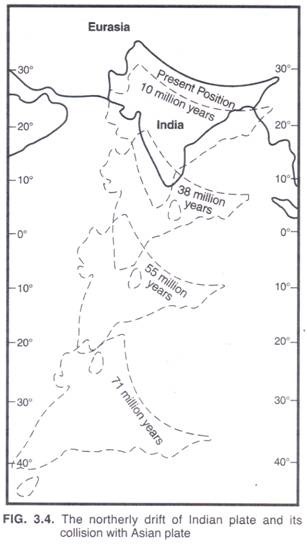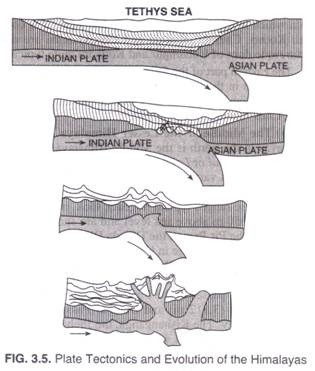Here is your paragraph on the Theory of Plate Tectonics and Origin of Continents and Oceans !
Plate tectonics is the most recent and widely acclaimed theory which gives most satisfactory answers to intricate and puzzling questions regarding origin of continents and oceans, formation of mountains, occurrence of earthquakes and eruption of volcanoes.
The credit for introducing this theory goes to Harry Hess (1960), R.S. Dietz (Global Tectonics, 1961), W.J. Morgan and Le Pichon (Sea Floor Spreading and Continental Drift, 1968). Plate tectonics is a theory of global dynamics in which the lithosphere is believed to be broken into a series of separate plates that move in response to convection in the upper mantle.
Plate is a broad segment of lithosphere (including rigid upper mantle plus oceanic and continental crust) that is about 100 km thick and floats on the underlying asthenosphere and moves independently of other plates. The margins of the plates are sites of considerable geological activity such as sea-floor spreading, volcanic eruptions, earthquakes, crustial deformation, mountain building and continental drift.
ADVERTISEMENTS:
There are three types of plate boundaries, viz., (a) constructive, (b) destructive, and (c) conservative. Constructive boundaries represented zones of ‘diverging margins’. In this case, two plates move away from each other.
Destructive boundaries are also known as ‘converging margins’. In this case, two plates move towards each other, converge and in the process one plate overrides the other. The overridden plate is sub-ducted and goes under the asthenosphere and is lost or consumed. Where two plates slide fast along transform faults neither creating nor destroying earth crust it is called conservative zone.
ADVERTISEMENTS:
It is the converging boundary of the plates where folded mountains like the Himalayas build up. When two convergent plates composed of continental crusts collide against each other, the denser plate is subducted under the lighter plate. The resultant lateral compression squeezes and folds the sediments deposited on either side of the continental plate margins or sediments of the geosynclines lying between the two.
The Himalayas are the product of such a process on the conveyance zone of the Asiatic plate in the north and the Indian plate in the south. Some 70 million years ago, the Indian plate started moving towards the Asian plate and the Tethys Sea began to contract due to the movement of Indian and Asian plates towards each other.
Since the Indian plate was made up of denser material than the Asian plate, the former began to sub-duct under the latter causing lateral compression of the marine sediment in the bed of the Tethys (Fig. 3.4). Geologists believe that the sediment got folded in three successive phases giving rise to three important ranges of the Himalayas.
Although the process of the Indian plate moving towards the Asian plate and formation of the Himalayan ranges was more or less completed about 10 million years ago, it is believed that the Indian plate is still moving northwards and the Himalayas continue to rise further. Evidences regarding rise in the Himalayas have already been mentioned in the foregoing paragraphs.
Different stages of movement of the Indian plate and the evolution of the Himalayas is illustrated in Figure 3.5.
Recent studies have shown that convergence of the Indian plate and the Asian plate has caused a crustal shortening of about 500 km in the Himalayan region. This shortening has been compensated by sea floor spreading along the oceanic ridge in the Indian Ocean.
Since the northward movement of the Indian plate is still continuing the height of the Himalayan ranges is increasing with the passage of time. It has been estimated that the Indian plate is still moving northward at a rate of about 5 cm per year.
As a result of this movement, one more fracture has appeared in the outer fringes of the Shiwalik Hills which demarcates these hills from the Ganga Plain. Geologists postulate that a new mountain chain would be formed in the Ganga basin forcing the rivers of this region to migrate further south. This clearly indicates that the process of upheaval of the Himalayas is not yet over and will continue for a pretty long period in the times to come.

